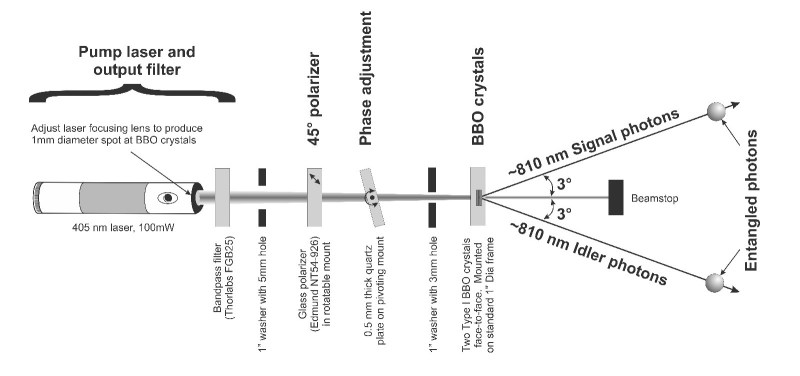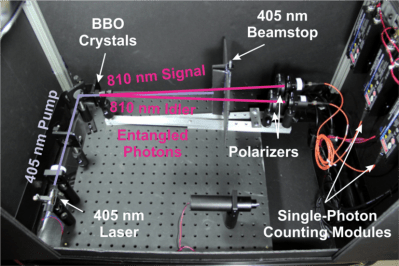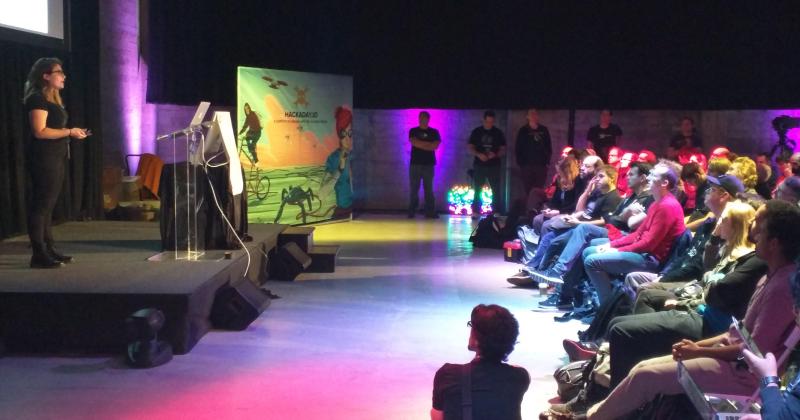For those of you that weren’t at the Hackaday SuperConference, it started off with a pretty intense talk that could have been tough for anyone to follow. However, [Shanni Prutchi] presented her talk on quantum entanglement of photons in a way that is both approachable, and leaves you with plenty of hints for further study. Check it out in the video below, and join us after the break for a rundown of what she covered in her presentation.
Quantum Entanglement of Photons
[Shanni Prutchi] is studying Electrical and Computer Engineering at Rowan University and has already been published on the topics of radio astronomy and radiation measurement. But more directly connected to this talk is her co-authorship of the book Exploring Quantum Physics Through Hands-On Projects.
 [Shanni] explains the current methods of identifying two entangled photons. She is not just explaining how one could conduct this experiment, she is explaining how she did conduct this experiment. First, a UV laser beam is sent through a non-linear optical crystal. On the other side, randomly polarized entangled photons are emitted. The polarization of these pairs will be forever linked, and measuring the angle of polarization of one indicates the angle of the other. It is then just a matter of identifying which photons are linked and using the entanglement for a purpose.
[Shanni] explains the current methods of identifying two entangled photons. She is not just explaining how one could conduct this experiment, she is explaining how she did conduct this experiment. First, a UV laser beam is sent through a non-linear optical crystal. On the other side, randomly polarized entangled photons are emitted. The polarization of these pairs will be forever linked, and measuring the angle of polarization of one indicates the angle of the other. It is then just a matter of identifying which photons are linked and using the entanglement for a purpose.
Quantum Teleportation and Quantum Key Distribution
 The two particles have properties that are tied to each other in such a way that the quantum state of one particle exhibits an immediate correlation to its entangled particle, even when the particles are separated. Of course it is the separation of these particles that makes trait is most useful.
The two particles have properties that are tied to each other in such a way that the quantum state of one particle exhibits an immediate correlation to its entangled particle, even when the particles are separated. Of course it is the separation of these particles that makes trait is most useful.
The first example is a form of quantum teleportation. The sender manipulates one entangled photon while the receiver measures this. The manipulation happens instantaneously despite any physical distance between the two. The particle itself doesn’t move, but in essence the entangled particle on the receiving end shows the exact same properties as the one on the transmitting end. This gives the appearance that the particle has been teleported from one place to another. [Shanni] mentions that it is actually destruction and recreation of a particle, rather than movement.
The second application she covers is Quantum Key Distribution. This is a form of Quantum Cryptography where several pairs of entangled photons are used in something of a public/private key pair. The virtue of this system is that it make it possible to immediately detect a man-in-the-middle attack. However, as [Shanni] mentions, there is current research that points to vulnerabilities in this system.
As [Shanni] works her way through school we hope to see and hear more from her; we’ll be brushing up on our physics vocab in the meantime. If you didn’t get a chance to talk to [Shanni] at SuperCon you can find her on Twitter as @shannirosa.


















good post. ty brandon
It was a good talk, but she never got to (or I missed) the results. Can we manipulate these photons? What is in the way of using this now?
if they can, and make it small enough, picture the future of mobile computers. in the simplest way, you could access your Q-fi (quantum wifi) any where in the world.
No, quantum entanglement is a correlation between two particles that does not allow useful information to be teleported. Quantum teleportation requires a classical communications channel, in addition to a pair of entangled particles.
Quantum technology is cool – it leads to new types of computers and cryptography, among other things – but “access your wifi anywhere in the world” is not one of the benefits it gives.
Amazing stuff. The only problem is that talks like this makes me feel even more stupid than I already felt. Excuse me while I go sit in the corner with my dunce cap on.
Hahaha, can just kind of understand what she’s saying….no comprendo.
Embrace the feeling, mate! That’s your brain getting smarter while simultaneously realising how little we all really understand.
See Dunning Kruger effect ;
https://en.m.wikipedia.org/wiki/Dunning–Kruger_effect
Something tells me that a room with an infinite number of corners will have to be constructed to accommodate all the dunces. Where’s the smart phone app that I can use to reserve my corner?
What’s the song at the start of the video?
It’s intro music made for the Superconference
There is much more yet to be discovered. Much which Einstein and Shannia speaks of and our scientistsis in the URANTIA Book, our generations have yet to discover.
Tl;Dr.
Urantia book is:
“The authors introduce the word “Urantia” as the name of the planet Earth and state that their intent is to “present enlarged concepts and advanced truth.”[1][2] The book aims to unite religion, science and philosophy,[3] and its enormous amount of material about science is unique among literature claimed to be presented by celestial beings.[4] Among other topics, the book discusses the origin and meaning of life, humankind’s place in the universe, the relationship between God and people, and the life of Jesus. It has been described as “a rich and complex moral narrative, equal parts Tolkien and St. Paul.”[5]”
(https://en.wikipedia.org/wiki/The_Urantia_Book)
In other words, a work of religious christian fiction. It has nothing to do with science. Read if you’re bored, or better, not read it at all.
Ok
Your paste in response is from probably an Amazon employee describing whats for sale. If you haven’t read these papers than you have absolutely no ground to stand on.
The signal and idler would never be the same wavelength if the two BBO crystals are mounted face to face. Are they cut for different phase matching angles or did I miss something?
Never-mind, I figured it out. They are both idler beams. The Type I cut of the BBO would give a 202.5nm signal, but BBO has very high absorption at that wavelength.
There is actually a signal and an idler. This is spontaneous parametric downconversion. Although I am not sure of the point in using two crystals face to face, as you wouldn’t know which photon came from which crystal (it may not matter), and the AR coatings are not perfect, so there is potential for parametric amplification / oscillation, and additional scattering that may induce error in the measurement. Also the multi-mode fiber used on the single photon detectors would (could) cause huge (relatively) errors in the coincidence correlation measurement.
Am I the only one who finds the entanglement of photons such a bullcrap? The fact that these photons left the crystals at the same time doesn’t make them entanled and the fact that you can’t observe the “entangled” photon-brother doesn’t mean that you can assume that it disappeared the moment that you observed the other photon?
A basic experimental setup to illustrate quantum mechanics’ peculiar wave-particle duality is the Young’s double split experiment https://en.wikipedia.org/wiki/Double-slit_experiment. A slightly more comfortable (at least for some) way of describing it is to to think of particles (photons, electrons etc.) as propagating as probabilistic waves but interacting as particles with quantifiable properties. Entanglement occurs as a consequence of quantum properties of the system being conserved in all interactions. The interaction here being the creation of the two photons. Forget most of what your common sense is trying to tell you and say good bye to the idea of an objective reality – we’re not in Kansas any more Toto.
Original paper adds more clarity:
http://arxiv.org/pdf/quant-ph/9810003.pdf
I’m Shanni’s co-author of the book “Exploring Quantum Physics Through Hands-On Projects”. I’m also Shanni’s father (and very proud of her!)
I wanted to address some of the comments to this blog post to place Shanni’s talk in context, as well as to provide further references for Hackaday followers who would like to start experimenting with quantum technologies.
First of all, the theme of the HaD SuperCon was “Hardware Creation”, so Shanni’s lecture appropriately centered on the way in which we built our entangled photon source, which is the first key component used in the majority of current systems used for quantum state teleportation and quantum key distribution.
Quantum Mechanics is without doubt mind boggling, and some of its formulations require advanced college-level mathematics. However, that doesn’t mean that quantum technology is out of reach from anyone without the necessary math foundations. In fact, we use electronic devices based on quantum principles (like FETs and LEDs) the whole time without thinking of the physical principles that make them work.
Tooting our own horn a bit, in our book “Exploring Quantum Physics Through Hands-On Projects”, we try to help our readers build an intuitive understanding of the principles behind quantum mechanics through practical construction and replication of the original experiments that have brought us to our current understanding of this field. We limit the math to basic algebra and trigonometry, and hope that those interested in a deeper understanding will consult some of the excellent books available on its theory.
The setup that we constructed for experimenting with entangled photons, and which we describe in detail in our book, is similar to the type used by many academic institutions. In fact, a number of colleges and universities have specifically replicated our setup for their undergrad and graduate Physics and EE teaching labs. As we also describe in the book, proof that the photons are entangled comes from running an experiment to test violations of Bell’s inequalities.
The best explanation for the layperson that I’ve seen regarding the Einstein vs. Bohr disagreement and the significance of Bell’s Inequalities was presented by Prof. Jim Al-Khalili in BBC Four’s TV program “The Secrets of Quantum Physics”, Part I, “Einstein’s Nightmare”. I heartily recommend anyone interested in this field to watch it! Another excellent source for accessible explanations on Bell’s Inequalities and the applications of quantum technologies is Prof. Anton Zeilinger’s book “Dance of the Photons: From Einstein to Quantum Teleportation”. BTW, Zeilinger is widely considered to be the top quantum physics experimentalist today, so his words on quantum technologies come straight “from the horse’s mouth”.
Lastly, we always post additional information and whitepapers on our work at http://www.diyPhysics.com, so please look there for practical hints and tips on replicating our setups.
Cheers,
David
Original paper from 2002:
http://arxiv.org/pdf/quant-ph/0205172.pdf
Thanks for posting the link to an online source for Dehlinger and Mitchell’s excellent paper! Indeed, that is the paper (along with the original design by Paul Kwiat) that we reference in our book on the basis for our implementation for the entangler portion of the experimental setup.
Cheers,
David